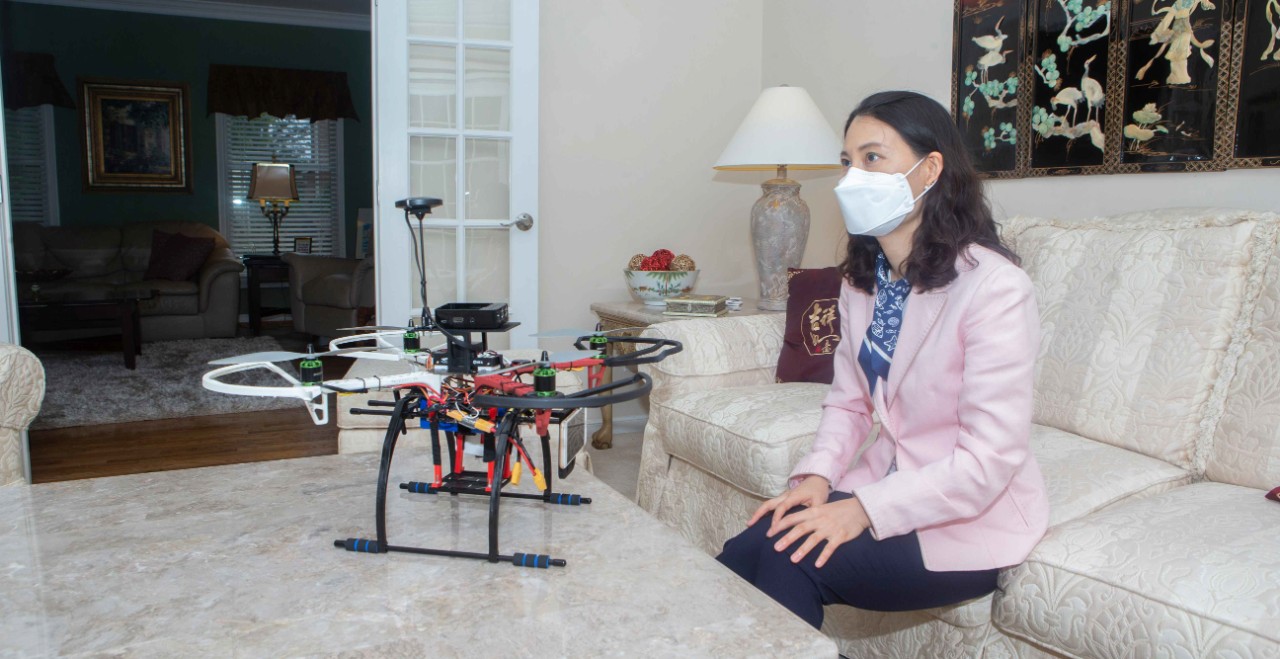
New UC telehealth drone makes house calls
Pilot project demonstrates how drones can improve access to health care
The University of Cincinnati has invented a new telehealth drone to improve access to medical services regardless of location.
Inventors Victoria Wangia-Anderson, Manish Kumar, Seung-Yeon Lee and Debi Sampsel from three colleges at UC collaborated to develop a semi-autonomous prototype that can be dispatched right to people’s homes. The drones are big enough to carry medicine or medical supplies but small enough to maneuver the tight confines of a home using navigational algorithms developed by UC engineers.
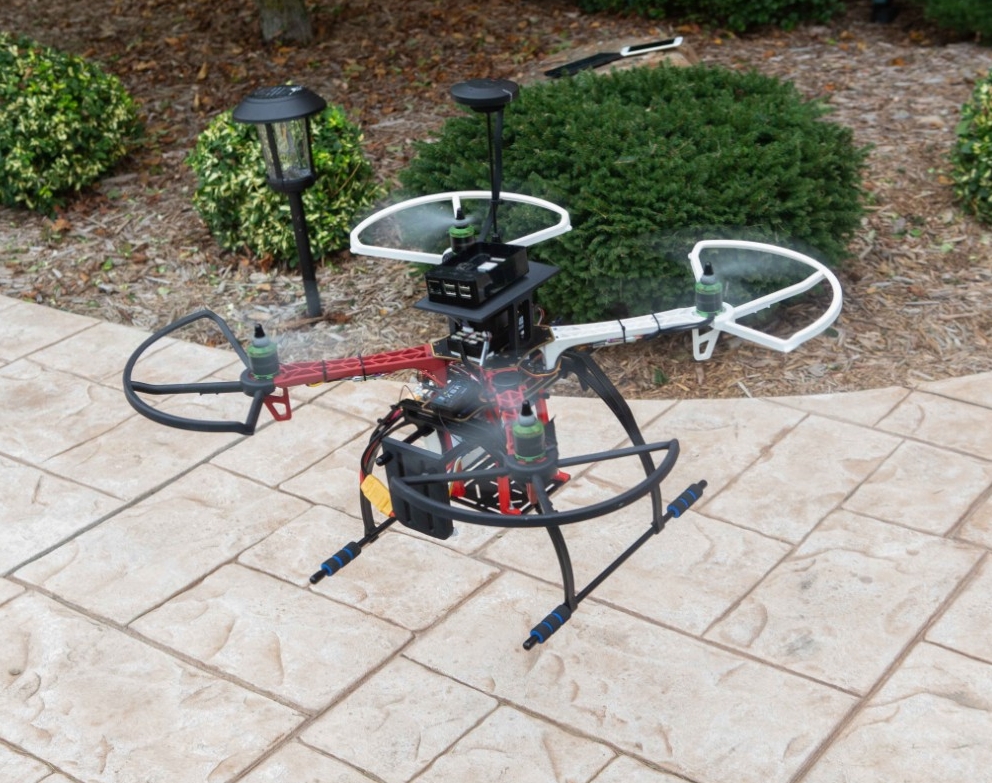
Researchers at three colleges at UC invented a new prototype telehealth drone that can be dispatched to a patient's home. It's large enough to carry medical cargo but small enough to navigate the interior of a home comfortably. Photo/Joseph Fuqua II/UC Creative + Brand
Still in development, the drone has cameras and a display screen so patients can talk to health care professionals from the comfort of their home. The prototype carries a waterproof box the size of a small first-aid kit to deliver medical supplies or collect self-administered lab tests.
“Most drones rely on controllers that work on radio communication and require line-of-sight for safe, remote operation. That’s why most drones have limited operational range,” said Kumar, a professor of mechanical engineering. He is director of the CDS Lab and co-director of the UAV MASTER Lab in the UC College of Engineering and Applied Science.
“If you want beyond line-of-sight control, you need some autonomous capabilities,” he said.
His lab has been working on autonomous systems that combine artificial intelligence with a suite of sensors that allow drones to navigate a cluttered and complex three-dimensional environment, like the entrance to a person’s home and living room.
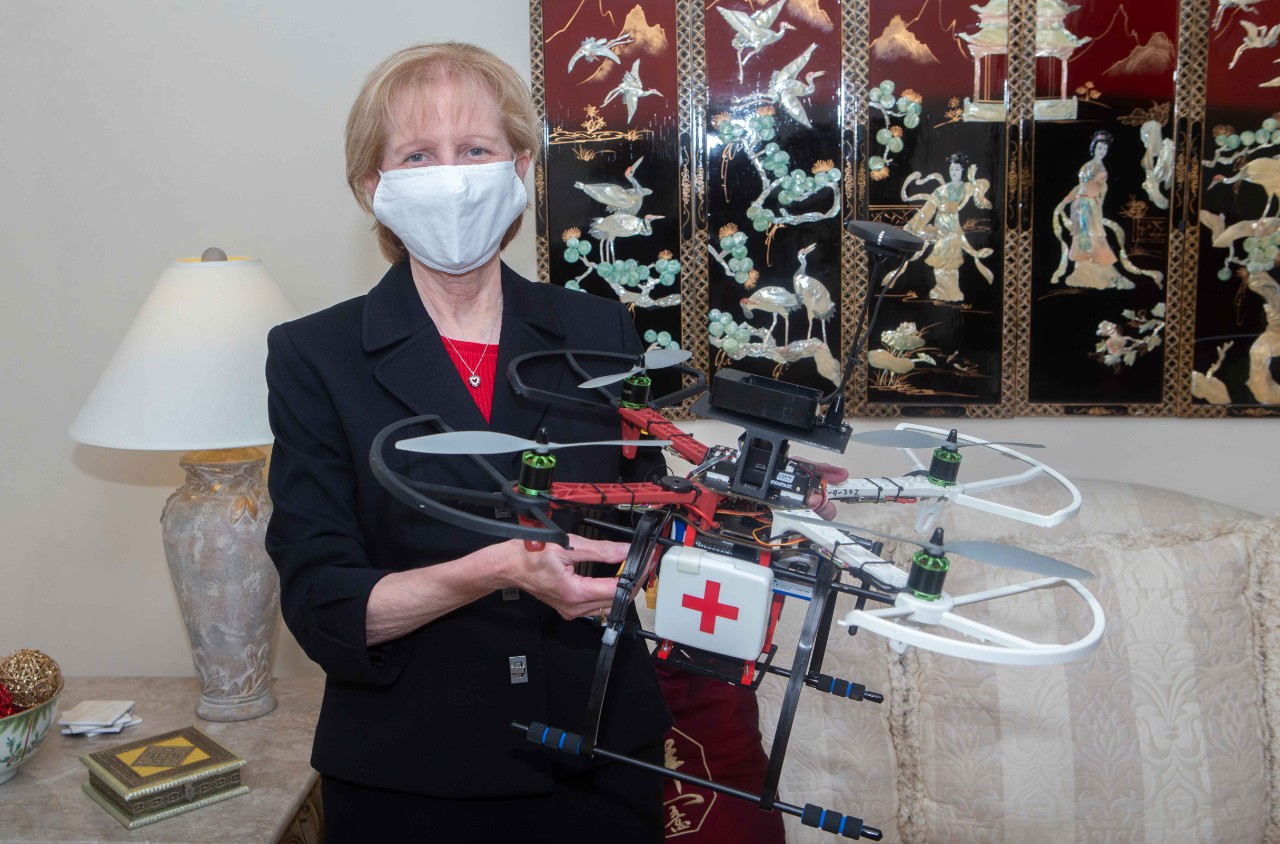
Debi Sampsel, director of telehealth in UC's College of Nursing, holds a telehealth drone that can respond to a patient's home. It has a video screen and a cargo container for medicine. Photo/Joseph Fuqua II/UC Creative + Brand
Kumar and his engineering students began working with Sampsel, director of telehealth at UC’s College of Nursing, seven years ago to apply technology to real-world problems of accessibility. UC has been experimenting with sensors and other technology in a "smart house" to develop aids for older or disabled residents in a partnership with the retirement campus Maple Knoll, Inc., which provides a nursing home, independent living, assisted living and rehabilitative care.
Sampsel and UC professor Tamilyn Bakas were exploring new technology with telehealth robots for participants living independently. Sampsel said the logistics and communications needed to perform these tasks remotely got her thinking about ways telehealth delivery could be improved to reduce health care disparities regardless of where people live.
The researchers in UC’s College of Nursing, College of Allied Health Sciences and College of Engineering and Applied Science secured a UC Office of Research grant to develop a prototype to test the feasibility of dispatching a telehealth care delivery drone to a patient's home to provide health assessments or medical interventions.
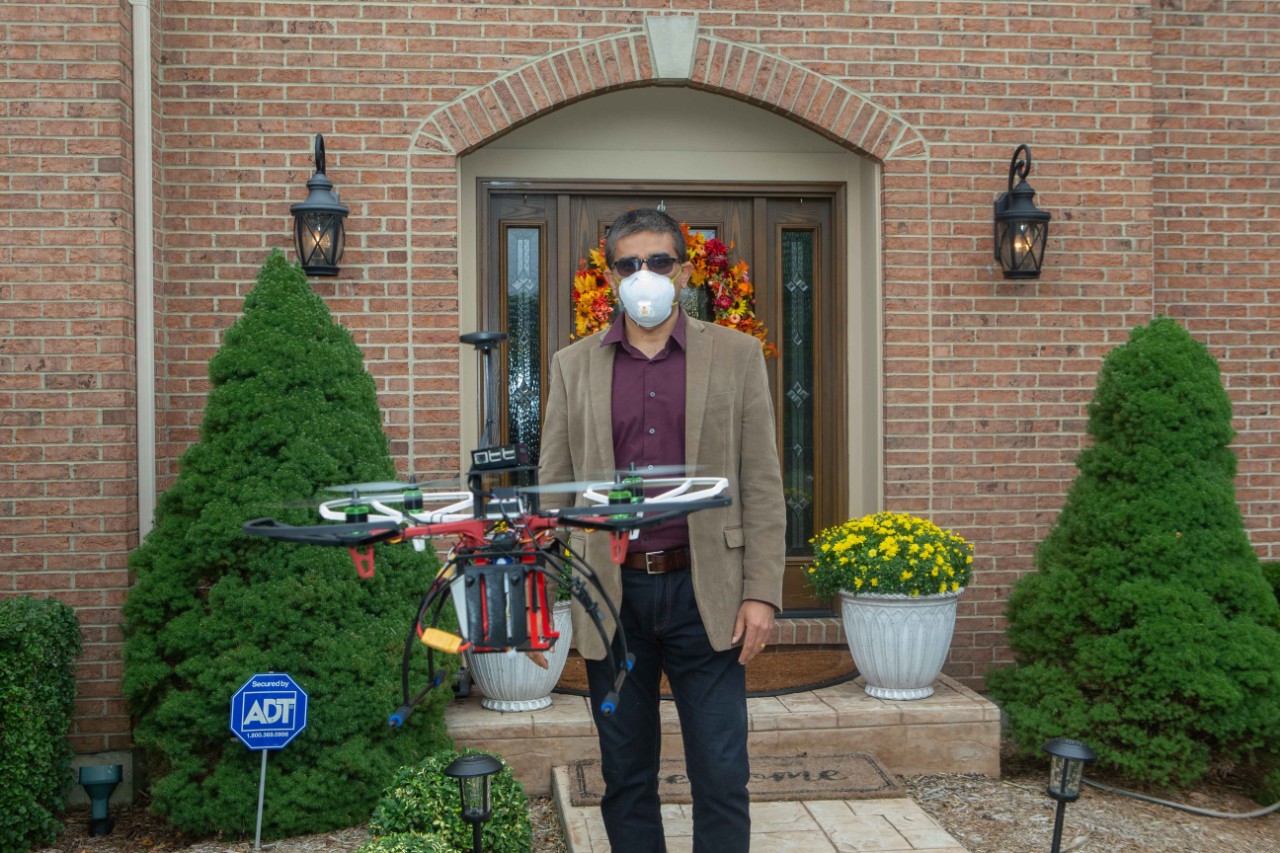
A telehealth drone hovers in front of UC College of Engineering and Applied Science professor Manish Kumar. Kumar and his students have developed drones with semi-autonomous navigation that allow them to be dispatched to a patient's home. Photo/Joseph Fuqua II/UC Creative + Brand
“A big advantage of drones is their ability to navigate using satellite or even cellular communications,” Kumar said.
Project collaborator Seung-Yeon Lee, an associate professor of nutrition sciences in the UC College of Allied Health Sciences, said the telehealth drone can reach individuals in some rural places where in-person nutrition education or counseling and high-speed internet are not readily available.
“We can use the drone to assess both availability and accessibility of foods at home as well as kitchen tools and appliances. Based on this assessment, we can tailor nutrition education and counseling,” Lee said.
“It can be used to promote healthy eating as a primary prevention or to help people with diet-related chronic disease management, such as diabetes, as a tertiary prevention.”
When COVID-19 hit, telehealth emerged as a prime way to talk with healthcare professionals and receive certain types of therapies. Telehealth is here to stay.
Debi Sampsel, UC College of Nursing
The world might seem smaller every year. But access to health care remains a persistent problem.
Access to care has a profound impact on a person’s health and well being. But in the United States, 1 in 4 people does not have a primary care provider or local health center where they can receive regular medical services. The Office of Disease Prevention and Health Promotion says increasing access to routine medical care is a vital step toward improving people’s health.
Wangia-Anderson, a professor of health informatics in UC's College of Allied Health Sciences, said she is very interested in mitigating health disparities. Telehealth drones have useful public health applications such as delivering essential materials like medication or test kits or surveying public health conditions in neighborhoods to identify effective interventions. They also can be used to assess living conditions or to provide a substitute for in-person care during a pandemic or epidemic outbreak. The data they provide can be useful for interventions, clinical care, population health and other decision-making, she said.
“Patients with limited access to transportation may benefit from telehealth sessions and delivery, aiding in reducing health disparities,” she said.
The multidisciplinary project is giving many students a chance to collaborate. Among the participants are UC College of Engineering and Applied Science students Rumit Kumar, James "Zach" Wells, Shubham Agarwal, Oyindamola Omotuyi, Chengal Reddy Mallu and Ethan Fitz. In the UC College of Allied Health Sciences, graduate students Sam Krutka and Mikaela Stemen also are contributing.
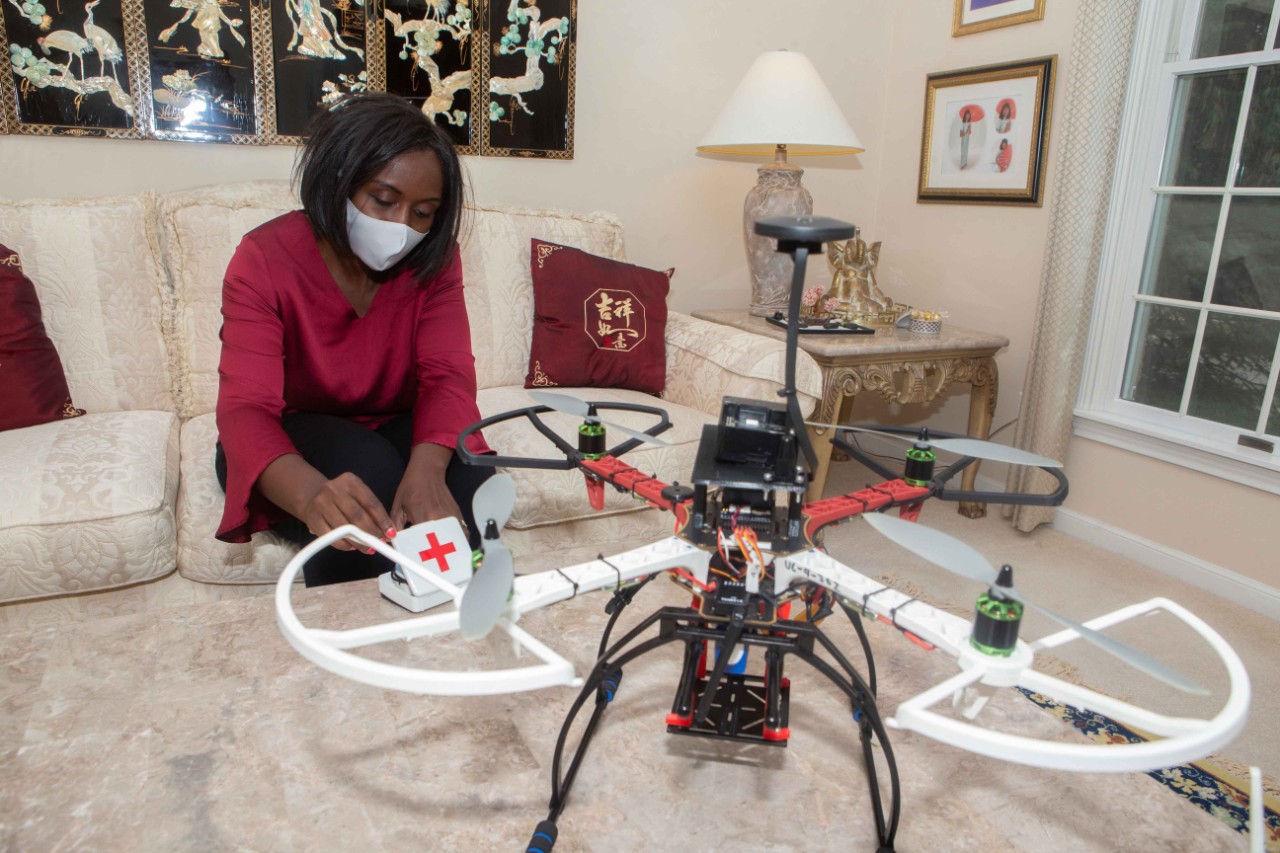
Victoria Wangia-Anderson, a professor and director of health informatics in UC's College of Allied Health Sciences, demonstrates how the drone can deliver medicine or at-home test kits. Photo/Joseph Fuqua II/UC Creative + Brand
Health disparities are most obvious in rural areas where medical services are far scarcer and more distant. Just 11% of doctors serve rural populations. But even in urban areas, access to health care professionals remains an issue.
Limited access to health care is an even bigger concern outside the United States. More than 1 billion people live off dirt roads that can limit access to doctors, pharmacies or hospitals, particularly during natural disasters like floods or storms.
When COVID-19 spread across the globe, patients were more likely to postpone or forego health care for fear of contagion. The pandemic shined a spotlight on the valuable role that telehealth plays in managing health care, Sampsel said.
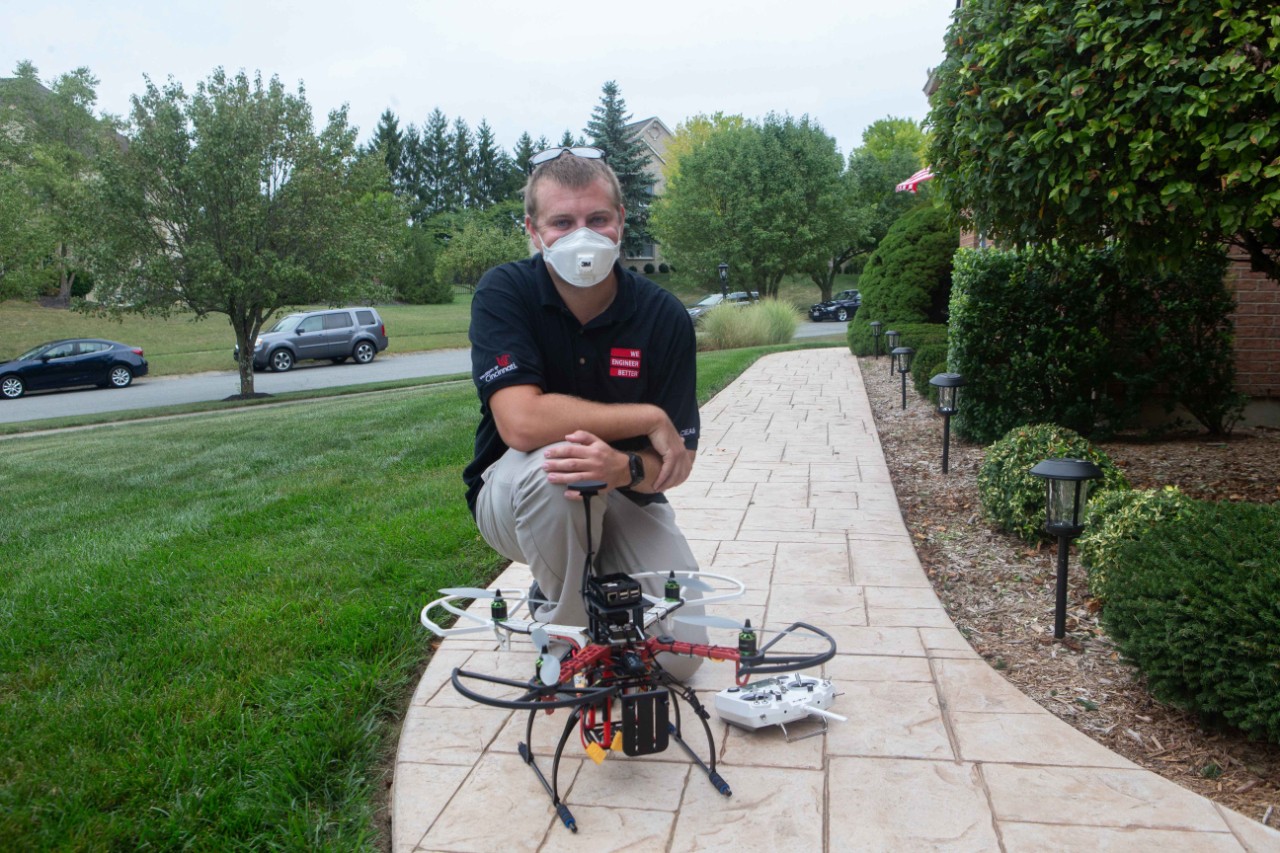
UC College of Engineering and Applied Science student James "Zach" Wells operates a telehealth drone. Photo/Joseph Fuqua II/UC Creative + Brand
“When the COVID-19 pandemic began, we saw a need for telehealth care delivery drones to provide health care in the home and in locations where access to care is not readily available,” Sampsel said.
With a diverse background in using telehealth for education, research and practice, Sampsel said she sees big advantages in delivering remote care access by drone to homes or remote-care locations during emergencies.
“We can perform all kinds of functions: chronic disease management, post-operative care monitoring, health coaching and consultations,” she said. “And in the health care arena, there is no age limit. Telehealth services are useful from birth to death.”
Just as the pandemic has changed the workplace in unexpected and profound ways, it has changed health care delivery, Sampsel said.
“When COVID-19 hit, telehealth emerged as a prime way to talk with healthcare professionals and receive certain types of therapies,” she said. “Telehealth is here to stay.”
Featured image at top: Seung-Yeon Lee, an associate professor of nutrition sciences in UC's College of Allied Health Sciences, sits across from a telehealth drone that allows patients to talk face-to-face to health care professionals from the comfort of their home. Photo/Joseph Fuqua II/UC Creative + Brand

Three colleges at the University of Cincinnati partnered on a project to develop a telehealth drone that health professionals can send to a patient's home. Pictured from left are Professor Victoria Wangia-Anderson and Associate Professor Seung-Yeon Lee from the UC College of Allied Health Sciences, Director of Telehealth Debi Sampsel from the UC College of Nursing and Professor Manish Kumar from the UC College of Engineering and Applied Science. Photo/Joseph Fuqua/UC Creative + Brand
Impact Lives Here
The University of Cincinnati is leading public urban universities into a new era of innovation and impact. Our faculty, staff and students are saving lives, changing outcomes and bending the future in our city's direction. Next Lives Here.
Stay up on all UC's COVID-19 stories, or take a UC virtual visit and begin picturing yourself at an institution that inspires incredible stories.
Related Stories
Working out worked out for UC student Emma Kalinowski
May 5, 2025
When Emma Kalinowski first arrived at UC, she went through a handful of major changes before her burgeoning love of fitness led her to the School of Human Service's Exercise Science program. Now a senior about to graduate and inspired by a recent internship experience, she's readying to start a master's program in the fall. The CECH student spoke with us about her time at UC and her plans for a career in pediatric exercise physiology.
UC students explore transformative trends shaping the future
May 5, 2025
Student researchers at the University of Cincinnati offer speculative looks at the future of healthcare, education and entertainment. We’ll break down their analysis of what to watch for.
UC celebrates record spring class of 2025
May 2, 2025
UC recognized a record spring class of 2025 at commencement at Fifth Third Arena.
